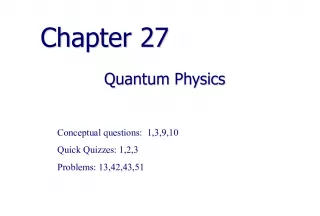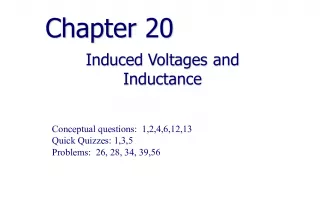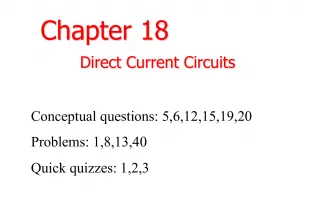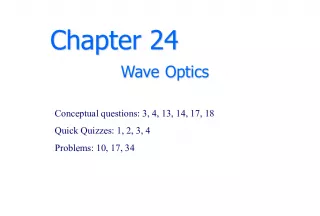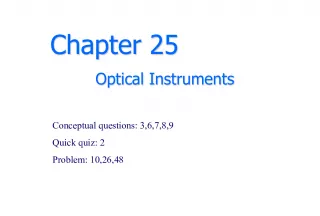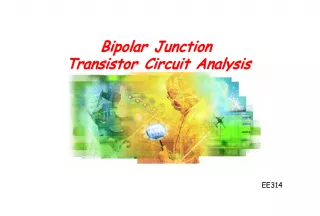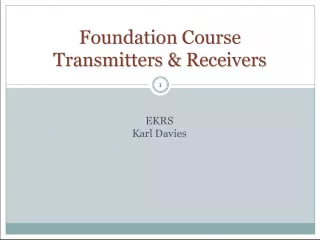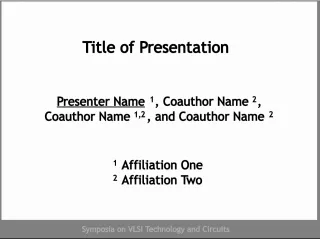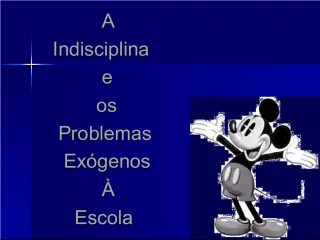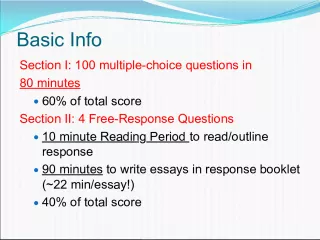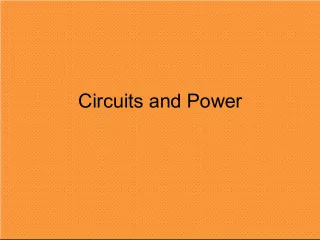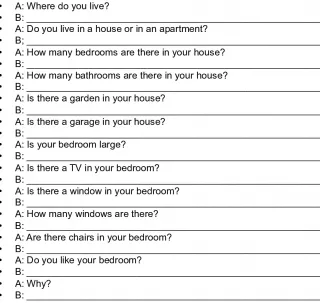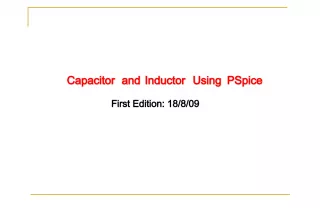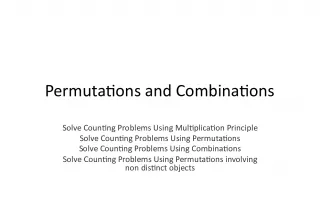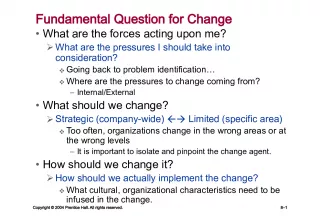"AC Circuits and Resistors: Conceptual Questions, Quick Quizzes, and Problems"
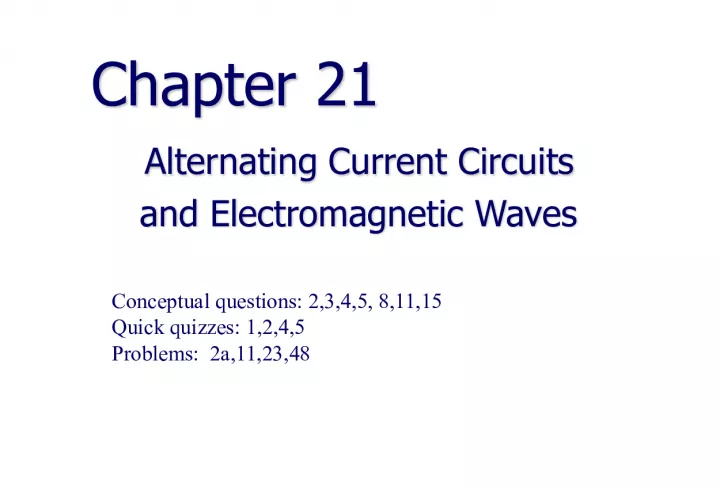

Chapter 21 covers Alternating Current Circuits and Electromagnetic Waves. This section discusses the behavior of resistors in an AC circuit, including the rate at which electrical energy is dissipated. The chapter includes conceptual questions, quick quizzes, and problems to reinforce understanding.
- Uploaded on | 3 Views
-
 keerthi
keerthi
About "AC Circuits and Resistors: Conceptual Questions, Quick Quizzes, and Problems"
PowerPoint presentation about '"AC Circuits and Resistors: Conceptual Questions, Quick Quizzes, and Problems"'. This presentation describes the topic on Chapter 21 covers Alternating Current Circuits and Electromagnetic Waves. This section discusses the behavior of resistors in an AC circuit, including the rate at which electrical energy is dissipated. The chapter includes conceptual questions, quick quizzes, and problems to reinforce understanding.. The key topics included in this slideshow are . Download this presentation absolutely free.
Presentation Transcript
1. Chapter 21 Chapter 21 Alternating Current Circuits Alternating Current Circuits and Electromagnetic Waves and Electromagnetic Waves Conceptual questions: 2,3,4,5, 8,11,15 Quick quizzes: 1,2,4,5 Problems: 2a,11,23,48
2. AC Circuit AC Circuit
3. Resistor in an AC Circuit Resistor in an AC Circuit
4. Resistors in an AC Circuit Resistors in an AC Circuit The direction of the current has no effect on the behavior of the resistor The direction of the current has no effect on the behavior of the resistor The rate at which electrical energy is dissipated in the circuit is given by The rate at which electrical energy is dissipated in the circuit is given by P = i 2 R P = i 2 R
5. rms Current and Voltage rms Current and Voltage The rms current is the direct current that would dissipate the same amount of energy in a resistor as is actually dissipated by the AC current The rms current is the direct current that would dissipate the same amount of energy in a resistor as is actually dissipated by the AC current Alternating voltages can also be discussed in terms of rms values Alternating voltages can also be discussed in terms of rms values
6. Ohm’s Law in an AC Circuit Ohm’s Law in an AC Circuit Ohm’s Law for a resistor, R, in an AC circuit Ohm’s Law for a resistor, R, in an AC circuit ΔV rms = I rms R ΔV rms = I rms R
7. What is the resistance of a lightbulb that uses an average power of 75 W when connected to a 60 Hz power source with a peak voltage of 170V? Problem 21.2.a
8. Which of the following statements might be true for a resistor connected to an AC generator? (a) P average = 0 and i average = 0 (b) P av = 0 and i av > 0 (c) P av > 0 and i av = 0 (d) P av > 0 and i av > 0. QUICK QUIZ 21.1
9. Capacitors in an AC Circuit Capacitors in an AC Circuit The current starts out at a large value and charges the plates of the capacitor, initially there is no resistance The current starts out at a large value and charges the plates of the capacitor, initially there is no resistance As the charge on the plates increases, the voltage across the plates increases and the current flowing in the circuit decreases As the charge on the plates increases, the voltage across the plates increases and the current flowing in the circuit decreases
10. Capacitors in an AC Circuit Capacitors in an AC Circuit The voltage lags the current by 90 o The voltage lags the current by 90 o
11. Capacitive Reactance and Ohm’s Law Capacitive Reactance and Ohm’s Law Ohm’s Law for a capacitor in an AC circuit Ohm’s Law for a capacitor in an AC circuit ΔV rms = I rms X C ΔV rms = I rms X C
12. Inductors in an AC Circuit Inductors in an AC Circuit The current in the circuit is impeded by the emf of the inductor The current in the circuit is impeded by the emf of the inductor The voltage across the inductor always leads the current by 90° The voltage across the inductor always leads the current by 90°
13. Inductive Reactance, X L , and Ohm’s Law Inductive Reactance, X L , and Ohm’s Law Ohm’s Law for the inductor Ohm’s Law for the inductor ΔV rms = I rms X L ΔV rms = I rms X L X L = 2 ƒL X L = 2 ƒL
14. The RLC Series Circuit The RLC Series Circuit The current in the circuit is the same at any time and varies sinusoidally with time The current in the circuit is the same at any time and varies sinusoidally with time
15. Current and Voltage Relationships in an RLC Circuit Current and Voltage Relationships in an RLC Circuit The instantaneous voltage across the resistor is in phase with the current The instantaneous voltage across the resistor is in phase with the current The instantaneous voltage across the inductor leads the current by 90° The instantaneous voltage across the inductor leads the current by 90° The instantaneous voltage across the capacitor lags the current by 90° The instantaneous voltage across the capacitor lags the current by 90°
16. Phasor Diagrams Phasor Diagrams Represent the voltage across each element as a rotating vector, called a phasor Represent the voltage across each element as a rotating vector, called a phasor Its projection on the y- axis represents the varying instantaneous voltage in the circuit Its projection on the y- axis represents the varying instantaneous voltage in the circuit The diagram is called a phasor diagram The diagram is called a phasor diagram
17. Phasor Diagram for RLC Series Circuit Phasor Diagram for RLC Series Circuit The voltage across the resistor is on the +x axis since it is in phase with the current The voltage across the resistor is on the +x axis since it is in phase with the current The voltage across the inductor is on the +y since it leads the current by 90° The voltage across the inductor is on the +y since it leads the current by 90° The voltage across the capacitor is on the –y axis since it lags behind the current by 90° The voltage across the capacitor is on the –y axis since it lags behind the current by 90°
18. Phasor Diagram Phasor Diagram The phasors are added as vectors to account for the phase differences in the voltages The phasors are added as vectors to account for the phase differences in the voltages ΔV L and ΔV C are on the same line and so the net y component is ΔV L - ΔV C ΔV L and ΔV C are on the same line and so the net y component is ΔV L - ΔV C
19. ΔV max From the Phasor Diagram ΔV max From the Phasor Diagram The voltages are not in phase, so they cannot simply be added to get the voltage across the combination of the elements or the voltage source The voltages are not in phase, so they cannot simply be added to get the voltage across the combination of the elements or the voltage source is the phase angle between the current and the maximum voltage is the phase angle between the current and the maximum voltage
20. For the circuit of the figure below, is the voltage of the source equal to (a) the sum of the maximum voltages across the elements, (b) the sum of the instantaneous voltages across the elements, or (c) the sum of the rms voltages across the elements? QUICK QUIZ 21.2
21. Impedance and Ohm’s Law Impedance and Ohm’s Law Ohm’s Law can be applied to the impedance Ohm’s Law can be applied to the impedance ΔV max = I max Z ΔV max = I max Z
22. Problem 21.11. What value of capacitor must be inserted in a 60 Hz circuit in series with a generator of 170 V maximum voltage to produce an rms current output of 0.75 A? Problem 21.31. A 60.0 Q resistor, a 3.00 mF capacitor, and a 0.400 H inductor are connected in series to a 90.0 V 60 Hz source. Find the voltage across the LC combination. Repeat for the RC combination. Problems 11 and 23 Problems 11 and 23
23. Questions Questions
25. Power in an AC Circuit Power in an AC Circuit No power losses are associated with capacitors and pure inductors in an AC circuit No power losses are associated with capacitors and pure inductors in an AC circuit The average power delivered by the generator is converted to internal energy in the resistor The average power delivered by the generator is converted to internal energy in the resistor P av = I rms ΔV R = I rms ΔV rms cos P av = I rms ΔV R = I rms ΔV rms cos cos is called the power factor of the circuit cos is called the power factor of the circuit We may maximize P by adjusting the power factor We may maximize P by adjusting the power factor V I V R rms rms V V L C
26. Resonance in an AC Circuit Resonance in an AC Circuit Resonance occurs at the frequency, ƒ o , where the current has its maximum value Resonance occurs at the frequency, ƒ o , where the current has its maximum value To achieve maximum current, Z must be minimum To achieve maximum current, Z must be minimum This occurs when X L = X C This occurs when X L = X C
27. Transformer Transformer The use of iron core results in a the same magnetic flux in both Primary and secondary windings The power input into the primary equals the power output at the secondary The power input into the primary equals the power output at the secondary I 1 ΔV 1 = I 2 ΔV 2 I 1 ΔV 1 = I 2 ΔV 2
28. Transformer Transformer
29. 2. What is the impedance of an RLC circuit at the resonance frequency? 3. When a dc voltage is applied to a transformer, the primary coil sometimes overheats and burns. Why? 4. Why are the primary and secondary coils of a transformer wrapped on an iron core that passes through both coils? Conceptual questions Conceptual questions
30. Hertz’s Basic LC Circuit Hertz’s Basic LC Circuit When the switch is closed, oscillations occur in the current and in the charge on the capacitor When the switch is closed, oscillations occur in the current and in the charge on the capacitor When the capacitor is fully charged, the total energy of the circuit is stored in the electric field of the capacitor When the capacitor is fully charged, the total energy of the circuit is stored in the electric field of the capacitor At this time, the current is zero and no energy is stored in the inductor At this time, the current is zero and no energy is stored in the inductor
31. EM Waves by an Antenna EM Waves by an Antenna
32. EM Waves by an Antenna EM Waves by an Antenna Because the oscillating charges in the rod produce a current, there is also a magnetic field generated Because the oscillating charges in the rod produce a current, there is also a magnetic field generated As the current changes, the magnetic field spreads out from the antenna As the current changes, the magnetic field spreads out from the antenna
34. Electromagnetic Waves are Transverse Waves Electromagnetic Waves are Transverse Waves The E and B fields are perpendicular to each other The E and B fields are perpendicular to each other Both fields are perpendicular to the direction of motion Both fields are perpendicular to the direction of motion Therefore, em waves are transverse waves Therefore, em waves are transverse waves
35. Properties of EM Waves Properties of EM Waves Speed of ALL electromagnetic waves is Speed of ALL electromagnetic waves is The ratio of the electric field to the magnetic field is equal to the speed of light The ratio of the electric field to the magnetic field is equal to the speed of light Electromagnetic waves carry energy as they travel through space Electromagnetic waves carry energy as they travel through space
36. In an apparatus such as that in the figure below, suppose the black disk is replaced by one with half the radius. Which of the following are different after the disk is replaced? (a) radiation pressure on the disk; (b) radiation force on the disk; (c) radiation momentum delivered to the disk in a given time interval. QUICK QUIZ 21.4
37. The Spectrum of EM Waves The Spectrum of EM Waves c = ƒ λ c = ƒ λ Wavelengths for visible light range from 400 nm to 700 nm Wavelengths for visible light range from 400 nm to 700 nm There is no sharp division between one kind of em wave and the next There is no sharp division between one kind of em wave and the next
38. 15. Does a wire connected to a battery emit an EM wave? 8. When light (or any EM wave) travels across a given region, what is that moves? 11. Suppose a creature from another planet had eyes that were sensitive to infrared radiation. Describe what he would see if he looked around the room you are in now. What would be bright and what would be dim? Questions Questions
39. Question 21.5 Question 21.5 Receiving radio antennas can be in the form of conducting lines or loops. What should the orientation of each of these antennas be, relative to a broadcasting antenna that is perpendicular to the Earth?
40. Problem 21.48 . Assume that the solar radiation incident on the Earth is 1340 W/m 2 . Calculate the power radiated by the Sun. The average Sun-Earth separation is 1.49 10 11 m.
41. MCAD MCAD A time varying magnetic field 1. Produces an electric field 2. Provides power to rotate an ac generator 3. Can induce currents to flow in a conductive loop 4. Both 1 and 3 A transformer is used to change 1. Voltage 2. Power 3. Current 4. Voltage and current
42. Which of the following most accurately describes light? Which of the following most accurately describes light? a. An electric and magnetic wave parallel to each other and perpendicular to the direction of propagation a. An electric and magnetic wave parallel to each other and perpendicular to the direction of propagation b. An electric and magnetic wave parallel to each other and parallel to the direction of propagation b. An electric and magnetic wave parallel to each other and parallel to the direction of propagation c. An electric and magnetic wave perpendicular to each other and perpendicular to the direction of propagation c. An electric and magnetic wave perpendicular to each other and perpendicular to the direction of propagation d. An electric and magnetic wave perpendicular to each other and parallel to the direction of propagation d. An electric and magnetic wave perpendicular to each other and parallel to the direction of propagation
